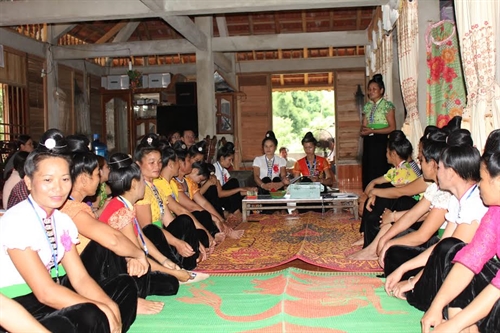 Society
Society

Over 1,720 remote ethnic minority women were supported with finance for income-generating activities through the establishment of women’s Village Savings and Loan Associations (VSLA).
 |
| Women in Na Hí Village, Hua Thanh Commune, Điện Biên District gather for their periodic Village Savings and Loan Association’s meeting. – VNS Photo Thu Trang |
ĐIỆN BIÊN – Over 1,720 remote ethnic minority women were supported with finance for income-generating activities through the establishment of women’s Village Savings and Loan Associations (VSLA).
This is a part of the results of the CARE International in Việt Nam’s Ethnic Minority Women’s Empowerment project (EMWE), which is being implemented in the northern mountainous provinces of Bắc Kạn and Điện Biên.
The project, running from July 2013 to June next year, is now supported with A$1.7 million by Australian Aid.
Under the project, 426 remote ethnic minority women were trained to identify and implement new climate resilient livelihood options.
The project also introduced authorities to CARE’s model of dialogue between ethnic minority communities and people’s councils, building their willingness to listen to ethnic minority women’s concerns.
Lê Xuân Hiếu, the project manager, said that women in remote ethnic communities in Việt Nam, including in Bắc Kạn and Điện Biên, were not benefiting equally from the remarkable economic growth.
They experienced high levels of poverty, unequal participation in economic opportunities, have limited options to adapt to changes in the climate, and had a limited voice in decisions that affect them, he said.
CARE International in Việt Nam started forming VSLAs to give a hand in reducing poverty in the provinces.
Lý Thị Minh, 30, a member of a VSLA in Na Hí Village, Hua Thanh Commune, Điện Biên District, said she joined the group when it was founded four years ago, and since then she was happy with it as she and other women saved together and took small loans from those savings.
“Earlier when I needed some money, I had to go to the bank and complete complicated procedures. Moreover, the bank loans with interest are for big amounts of money, so if I need a few million đồng, I didn’t know where to borrow it,” said Minh.
Her livestock and poultry used to lack food as she could not manage to find funds to buy feed.
Now with the VSLA model, not only Minh, but other women in the village can easily borrow small amounts of money from each other.
“We will not be worried when we have to buy medicines for a sick child, when we have to pay for monthly school fees or when we run out of capital for our trading,” said Minh.
But others expressed their worries about some limits of the model.
Lò Mai Kiêm, chairwoman of the Sơn La Province Women’s Association, said that in her province, households lived far from each other, so it was difficult for them to arrange their household work to meet each other twice a month.
Moreover, the model did not have a supervision mechanism to limit risks.
Hồ Thị Quý, head of the Women’s Economic Growth Boosting Division under the Việt Nam Women’s Union, said that different provinces should apply the model creatively to make it be suitable to the areas’ conditions.
Provinces should also apply the model step-by-step, run the model as a pilot programme first and then expand it the pilot model operated effectively, she said. – VNS